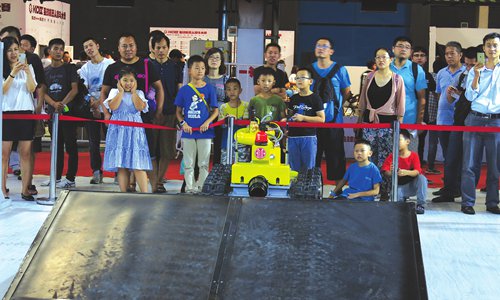
From the People's Daily app.
This is Story in the Story.
Since 2013, China has been the largest market for robots worldwide, with steady dynamic growth, according to the International Federation of Robotics (IFR).
China sold 30 percent of the robots in the world in 2016, making it the biggest robot seller in the world, with a sales volume close to that of Europe and the US combined.
According to a national robotics industry development report released by the Chinese Institute of Electronics, the size of China's robot market in 2018 is expected to reach $8.74 billion, and specialized robots are predicted to account for $670 million.
With a call for a "robot revolution," China has moved from developing industrial robots to specialized robots for dangerous tasks. These robots are equipped to counter nuclear leaks, security risks and military threats.
At the recent World Robot Conference held in Beijing, a variety of specialized robots were displayed at major domestic exhibition booths and attracted the most attention from visitors.
Today’s Story in the Story will look at China’s specialized robots.

Children and their parents watch a firefighting robot at the 2018 World Robot Conference in Beijing, on August 16. (Photo: Zhang Dan/GT)
When an earthquake and tsunami hammered northeastern Japan and damaged one of its largest nuclear power plants in 2011, the job of finding the missing fuel had to go to a robot, since the task would have been deadly for a human.
"It's very difficult to design a robot to operate in an unknown environment," Hajime Asama, a professor at the University of Tokyo, explained. "Until we send the bot in, we don't know what the conditions are. And after it's sent, we can't change it."
That is one of the features of specialized robots - working in unknown and extreme situations.
Focusing on specialized robots as a core technology, a Chinese intelligent equipment manufacturing enterprise has developed a type of specialized robot for nuclear radiation detection.
According to the sales manager Wang Liming, their robots can be used in environments with nuclear, biological or chemical contamination.
The one-meter high, black-and-white machine is equipped on all sides with cameras and has six gas sensors. Its battery lasts for a maximum of eight continual working hours. The robot's metal exterior shields it from a high level of nuclear radiation, allowing all the inner electronic parts and components to run smoothly, said Wang.
The robots can also be used in firefighting and in the petrochemical industry. They are sold to the Middle East and Southeast Asia, with nearly 30 exported annually, said Wang.
The China North Vehicle Research Institute, which belongs to China North Industries Group Corp Ltd, is involved in an international collaboration on robot rescuers.
Collaborating with Finland, Germany and Russia, the institute's Ground Unmanned Platforms Research and Development Center has modified a Russian robot used for nuclear disposal at the Chernobyl Nuclear Power Plant, developing it for use in disaster rescue.
Employee Tao Jin at the center said that the robot is designed to work in indoor areas, including areas that have collapsed, for example after an earthquake. The robot has various attachments that can be used in special situations. For example, an arm can be attached that will break down a door. Other attachments can be added for monitoring, striking an opponent, or rescue.
"Not only defense industry enterprises like our company are making specialized robots, but also private enterprises… The level of such robots produced in our country is not inferior to the US. We have different specializations," Tao said.
A "robotic security guard" developed by Beijing Aerospace Automatic Control Institute attracted great attention at the World Robot Conference. It moved around freely like a human guard, with greater competence.
For instance, it can lead the way if anyone gets lost; it can recognize a wanted suspect or thief, even at night; and it can detect a suspicious smoke or heat source immediately. More importantly, the "head" of the robot can transform into an unmanned aerial vehicle, monitoring and tracking targets.
Liu Xiujuan is the project leader for robots of this type. She said the major work of the institute is to research target detection and recognition, as well as navigation control.
In 2015, the Chinese government called for military-civilian integration in the science and technology sector. In response, the Beijing Aerospace Automatic Control Institute is using its technological edge to develop robots for civilian use.
Liu said the robot has already been put into use in a residential quarter called Meiyuanli in southern Beijing this April.
Specialized robots in security monitoring are widely used in shopping malls and unmanned factories around the country.
Song Aiguo, dean of the department of instrument and meter engineering at Southeast University, echoed that the current working model is man-robot collaboration. For example, five security guard robots can work in a shopping mall while one man is still needed to sit in the monitor room, which can highly improve working efficiency and economize on manpower.
But he also noted that the cost of security guard robots, at tens of thousands of dollars per unit, is not cheap at present, so only big companies and departments can afford them.
When talking about the future of the specialized robot market, Song is optimistic. He said China's specialized robots are used in a wider range of applications than other countries, giving the country an edge.
(Produced by Nancy Yan Xu, Terry Guanlin Li, Raymond Mendoza and Lance Crayon. Music by: bensound.com. Text from Global Times and People’s Daily.)


